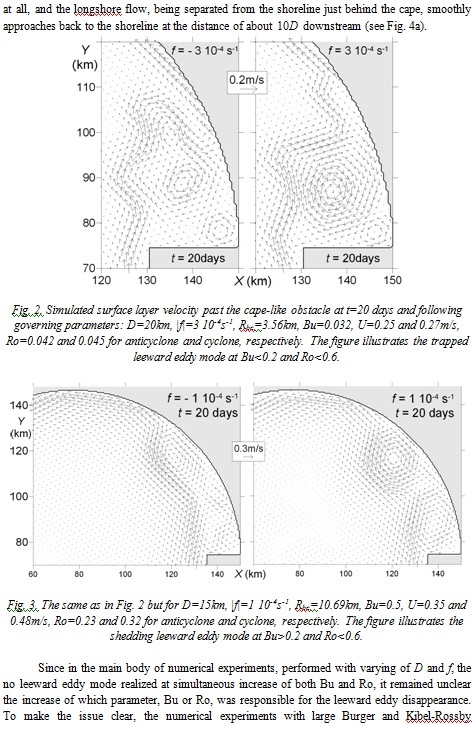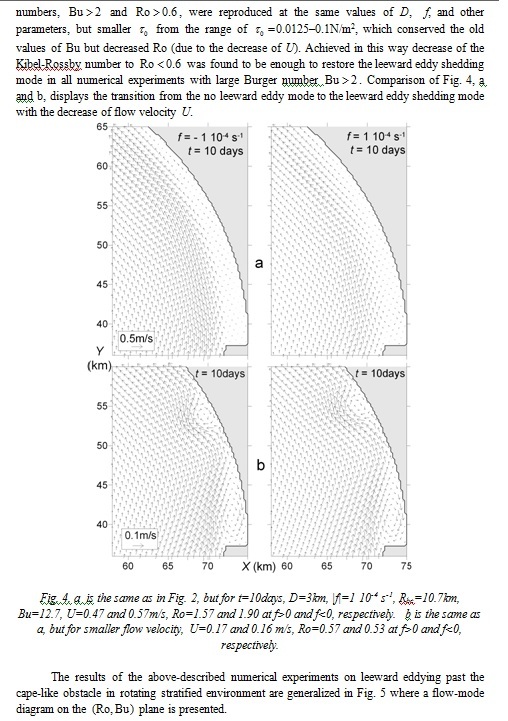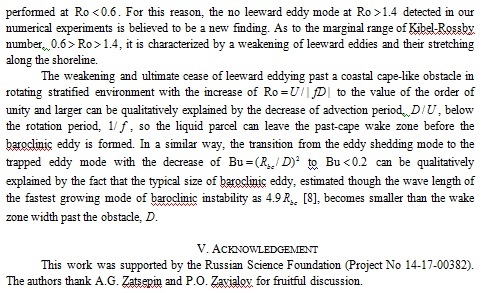Россия
BISAC NAT010000 Ecology
BISAC NAT045050 Ecosystems & Habitats / Coastal Regions & Shorelines
BISAC NAT025000 Ecosystems & Habitats / Oceans & Seas
BISAC NAT045030 Ecosystems & Habitats / Polar Regions
BISAC SCI081000 Earth Sciences / Hydrology
BISAC SCI092000 Global Warming & Climate Change
BISAC SCI020000 Life Sciences / Ecology
BISAC SCI039000 Life Sciences / Marine Biology
BISAC SOC053000 Regional Studies
BISAC TEC060000 Marine & Naval
It is shown that the process of eddy formation behind a coastal cape-like obstacle essentially depends on the method of generating the longshore current. Numerical simulations of the flow around a cape generated by transient longshore wind reveal different modes of eddy formation in rotating stratified environment depending on dimensionless parameters such as the Burger and Kibel-Rossby numbers, Bu and Ro, respectively. At Ro<0.6 depending on the magnitude of Bu either trapped anticyclonic or cyclonic eddy at Bu<0.2 or periodic eddy shedding at Bu>0.2 is realized. The eddies are weakened and stretched along the coastline at 0.4–0.61.4.
leeward eddy shedding, numerical simulation, Burger and Kibel-Rossby numbers
1. A.F. Blumberg and G.L. Mellor, “Diagnostic and prognostic numerical calculation studies of the South Atlantic Bight,” J. Geophys. Res., vol. 88(C8), pp. 4579-4592, 1983.
2. D. Boyer and L. Tao, “On the motion of linearly stratified rotating fluids past capes,” J. Fluid Mech, vol. 180, pp. 429-449, 1987.
3. P.A. Davies, P. Besley, and D.L. Boyer, “An experimental study of flow past a triangular cape in a linearly stratified fluid,” Dyn. Atmos. Oceans, vol. 14, pp. 497-528, 1990.
4. C. Dong, J.C. McWilliams, and A.F. Shchepetkin, “Island wakes in deep water,” J. Phys. Oceanogr., vol. 37, pp. 962-981, 2007.
5. D.N. Elkin and A.G. Zatsepin, “Laboratory investigation of the mechanism of the periodic eddy formation behind capes in a coastal sea,” Oceanology, vol. 53, pp. 24-35, 2013.
6. P.K. Kundu and I.M. Cohen, Fluid Mechanics, 2nd ed., Academic Press, New York, 2002, 766 p.
7. M.G. Magaldi, T.M. Özgökmen, A. Griffa, E.P. Chassignet, M. Iskandarani, and H. Peters, “Turbulent flow regimes behind a coastal cape in a stratified and rotating environment,” Ocean Modelling, vol. 25, pp. 65-82, 2008.
8. N. A. Phillips, “Energy transformations and meridional circulations associated with simple baroclinic waves in a two-level, quasi-geostrophic model,” Tellus, vol. 6, pp. 273-286, 1954.
9. R.D. Pingree and L. Maddock, “The effects of bottom friction and Earth’s rotation on an island’s wake,” J. Mar. Biol. Ass. UK, vol. 60, pp. 499-508, 1980.
10. E. Wolanski, J. Imberger, and M. Heron, “Island wakes in shallow coastal waters,” J. Geophys. Res., vol. 89(C6), pp. 10553-10569, 1984.
11. V. Zhurbas, I.S. Oh, and T. Park, “Formation and decay of a longshore baroclinic jet associated with transient coastal upwelling and downwelling: A numerical study with applications to the Baltic Sea,” J. Geophys. Res., vol. 111(С4), doihttps://doi.org/10.1029/2005JC003079, 2006.














